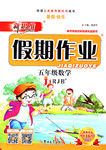题目内容
用方框中所给短语的适当形式填空
congratulate…on do damage to in honour of give out judging by |
1. ______ his accent, he may be from my hometown.
2. Many volunteers ______ food in the area hit by the earthquake.
3. The stadium was named ______ the club’s first chairman.
4. She ______ me warmly ______ my exam results.
5. The earthquake ______ the area where many houses fell down and many people were trapped in ruins.
练习册系列答案
 新思维假期作业寒假吉林大学出版社系列答案
新思维假期作业寒假吉林大学出版社系列答案
相关题目

